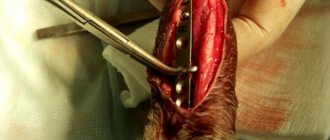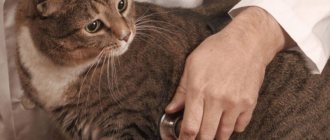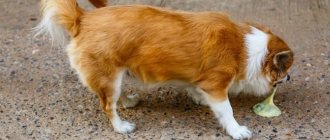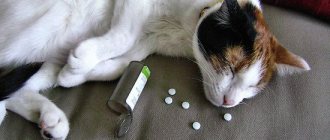Brain lesions occur in dogs much less frequently than in people, but lead to no less dire consequences. In addition, this condition is much easier to ignore, because the animal cannot complain about a deterioration in its health and a headache.
Therefore, owners of four-legged pets should know well what to do in such a critical situation. The health and even life of the pet largely depends on how quickly and correctly the owners react.
What is a stroke and a microstroke?
First, a little terminology. Stroke (from the Latin insultus “blow”) is an acute disorder of cerebral circulation, leading to the gradual death of cells and the death of entire parts of the brain.
Depending on which part of the brain is damaged, after a stroke the tailed patient loses the ability to move normally and perform functions usual for healthy animals.
There is also such a thing as a microstroke - a harbinger of a real major stroke. In the case of a transient ischemic attack, which is what, according to medical terminology, is called a microstroke, the congestion formed in the vessel resolves on its own without medical assistance. However, several micro-strokes are comparable to one large blow and also carry dangerous irreversible consequences.
What not to do!
When providing emergency care, it is important not to make the following mistakes:
- Do not apply cold to your head under any circumstances! Once upon a time this was often recommended. It has now been proven that this action not only does not bring anything useful, but can also cause harm, causing spasm of blood vessels, both already damaged and healthy, worsening the condition after a stroke.
- It is forbidden to try to give any pills without the instructions of a specialist!
- You should not give your dog any injections unless directed by your veterinarian!
Causes of stroke
The causes of stroke in dogs are:
- heart pathologies;
- hypertension;
- obesity;
- autoimmune diseases;
- traumatic brain injuries, concussions;
- severe helminth damage affecting the brain;
- poisoning;
- poor functioning of internal organs, for example, the thyroid gland, kidneys, liver;
- aneurysm or other vascular abnormalities;
- blood thickening;
- atherosclerosis;
- hormonal disbalance;
- severe shock or stress;
- tumors in the brain.
Diagnostics
The primary diagnosis can be established based on a neurological examination of the dog and identification of symptoms, the final diagnosis can be made after blood and urine tests, as well as examinations using hardware methods. To examine the animal's brain, magnetic resonance imaging or electroencephalography may be prescribed.
As methods of differential diagnosis, ultrasound of the abdominal organs or x-ray of the lungs can be performed. Analysis of the cerebrospinal fluid (CSF) will help clarify the nature of the stroke, which allows you to clearly distinguish the hemorrhagic form from the ischemic one.
Symptoms of the disease
The following signs will help you recognize a stroke in your pet in time and seek help from a veterinarian:
- the dog has become unusually lethargic, apathetic, or, on the contrary, overly active and even aggressive;
- the animal does not respond to its name, as if it does not recognize you, it looks confused;
- the dog has problems swallowing food and water;
- a clear asymmetry appeared on the muzzle;
- the pet begins to limp or lies completely motionless;
- labored breathing;
- convulsions, seizures resembling epileptic ones;
- dilation of one or both pupils;
- vomit;
- coma.
Canine microstroke is not characterized by such striking manifestations. However, if your pet refuses food, behaves strangely, for example, wanders aimlessly in circles around the apartment, refuses to go outside - immediately go to see a doctor.
Prevention
Animals that have a genetic predisposition to vascular disease, adult dogs must be shown to the veterinarian every 6 months - the doctor will select a diet and exercise to prevent the development of stroke.
Proper nutrition is the key to a dog’s health; the diet should contain more vitamins, vegetables, and raw meat. Sweets, salty foods, food from the human table are absolutely not suitable for animals, as they provoke the development of obesity. Owners should not allow their pets to become physically inactive - long walks, training, training, and active games help strengthen the heart and blood vessels.
Canine stroke is a rare but very dangerous disease that requires long-term treatment and recovery. Without timely and correct help, serious consequences develop - complete or partial paralysis, death of the pet, only a doctor can diagnose, carry out emergency therapy, and tell what to do at home. Regular visits to the veterinarian, proper nutrition, regular moderate exercise - these simple measures significantly reduce the risk of cerebral hemorrhage in your pet.
Types of stroke
There are two types of stroke: ischemic and hemorrhagic.
- An ischemic stroke or cerebral infarction provokes a disruption of the blood supply. Ischemic stroke occurs four times more often than hemorrhagic stroke. The main culprit of this scourge is a diseased heart, which has lost the ability to pump blood well and deliver it to the internal organs, including the brain.
- Hemorrhagic stroke, in turn, is characterized by rupture of a vessel and release of blood into the intracranial space. And although this type is the least common (occurs in only 25% of cases), it leads to the most severe consequences.
Who gets a stroke more often than others?
It should be noted that dogs are less susceptible to this terrible scourge than we are. Animals have fewer bad habits: they do not smoke, do not drink alcohol, but it is these human addictions that become the main provocateurs of stroke.
However, dogs also have their own risk group. It includes:
- older dogs;
- excitable dogs with unstable psyches;
- large breeds;
- animals prone to heart disease, for example, Boxer, St. Bernard, Malamute.
What common neurological diseases of dogs “masquerade” as a stroke?
There are several diseases that are often confused with stroke because their symptoms are incredibly similar:
- Peripheral vestibular syndrome. It is this that is more often than other ailments mistaken for a stroke. The exact causes of the development of this disease have not yet been identified, but it is believed that the main “lever” is age-related changes in the vestibular apparatus. In the absence of obvious organic lesions, the animal seems to be lost in space and ceases to distinguish the horizon line. The dog falls, walks in a circle, holds its head at an angle. Asymmetry appears on the muzzle, the eyes constantly move from side to side.
- Central vestibular syndrome. In appearance it resembles peripheral, although in this case the zones of the pons, medulla oblongata and vestibular nuclei are affected. The main sources of troubles are cysts and other neoplasms affecting these parts.
Please note that only an experienced veterinarian can make an accurate diagnosis after a thorough diagnosis.
Prohibited actions
It is important that at home it is strictly forbidden to “treat” the dog yourself and prescribe it medications and drugs, especially human ones. You should also not put ice or cooling bandages on your pet’s head. Cold provokes spasm of the head vessels and will complicate the situation.
Medical assistance should only be provided by a doctor, so at the first symptoms, immediately go to a veterinary hospital. The first three hours are the most important to saving your dog.
Before transportation, you will have to relieve the animal's condition. To do this you need:
- Remove the collar from your neck.
- Give the animal water.
- If the dog is overly excited and scared, you can add herbal sedatives to the water, for example “Bayun”, “Fidex”.
- In the car, be sure to place your pet on its side so that if it becomes nauseous, it does not choke on vomit.
- If your dog is drooling a lot, wipe the dog's mouth with a napkin or bandage.
- Be sure to talk to your pet in a quiet, calm voice the whole way, calm him down by gently stroking him.
Recovery at home
The doctor prescribes medications in the form of tablets or injections. Rehabilitation therapy is carried out using the same medications that were used for emergency treatment. Most often these are blood thinners, diuretics, and nootropics. The duration of the appointment is determined by the doctor.
Many animals are prescribed the drug Cerebrolysin. It accumulates in body tissues, acts slowly, and helps avoid complications after a stroke. Nicotinic acid restores blood circulation. Prozerin is recommended for paralysis. If an animal has lost its appetite due to a stroke, intravenous infusions are given to prevent dehydration.
Modern approaches to the treatment of disease in veterinary clinics
After all diagnostic measures and a comprehensive examination, the veterinarian will make a diagnosis and only then prescribe treatment. If a stroke is confirmed, the dog will be prescribed anticonvulsants, painkillers, drugs that restore cerebral circulation, vitamins, antipsychotics, and tranquilizers.
Most likely, the animal, especially in serious condition, will remain in the hospital for several days under the supervision of staff. As soon as the patient’s condition has stabilized, he will be discharged home under the responsibility of his owners. Owners will have to strictly follow all doctor's instructions and adhere to the prescribed medication regimen.
Consequences
If you seek veterinary help in a timely manner, a young dog has a chance for a full recovery. You will have to rebuild your pet's life: reduce stress, provide adequate nutrition, protect the animal from stressful situations. If the gift occurs in an elderly pet, inquire about the presence of chronic diseases, follow the veterinarian’s orders to avoid exacerbations and not provoke a second attack.
Some consequences may remain for life or periodically disappear and recur. Lameness appears, vision and hearing deteriorate, the pet does not follow commands, and urinary incontinence develops. The dog is transferred to lifelong veterinary nutrition. After a stroke, register your pet as an outpatient and visit the clinic for a preventive examination twice a year.
Rehabilitation after stroke
In addition to drug treatment, you will have to make a lot of efforts to restore your pet. Here are some recommendations for caring for such patients:
- Diet. During this period, the animal is fed liquid or crushed easily digestible food.
- Massage. Most likely, the attending physician will prescribe a course of massage. Remember to vary your doggy position to avoid bedsores.
- Room temperature. Protect your dog from drafts, remove wet diapers in a timely manner and make sure that the baby does not freeze. Now his body is very weakened and the risk of developing dangerous pneumonia is incredibly high.
- Physiotherapy. Can be prescribed as an additional method of rehabilitation.
Caring for a sick dog
When caring for a sick dog, it is very important to follow the schedule for taking all medications prescribed by the veterinarian.
It is also necessary to provide the dog with peace and eliminate stressful situations. Be patient with possible physiological deviations and new characteristics of the sick dog.
During the recovery period, the dog must be fed liquefied food, well ground, 3-5 times a day. If the dog is unable to swallow, take it to the veterinary clinic strictly on schedule for intravenous infusion of nutritional composition.
The owner of a sick animal will most likely have to master massage techniques to help his four-legged friend.











